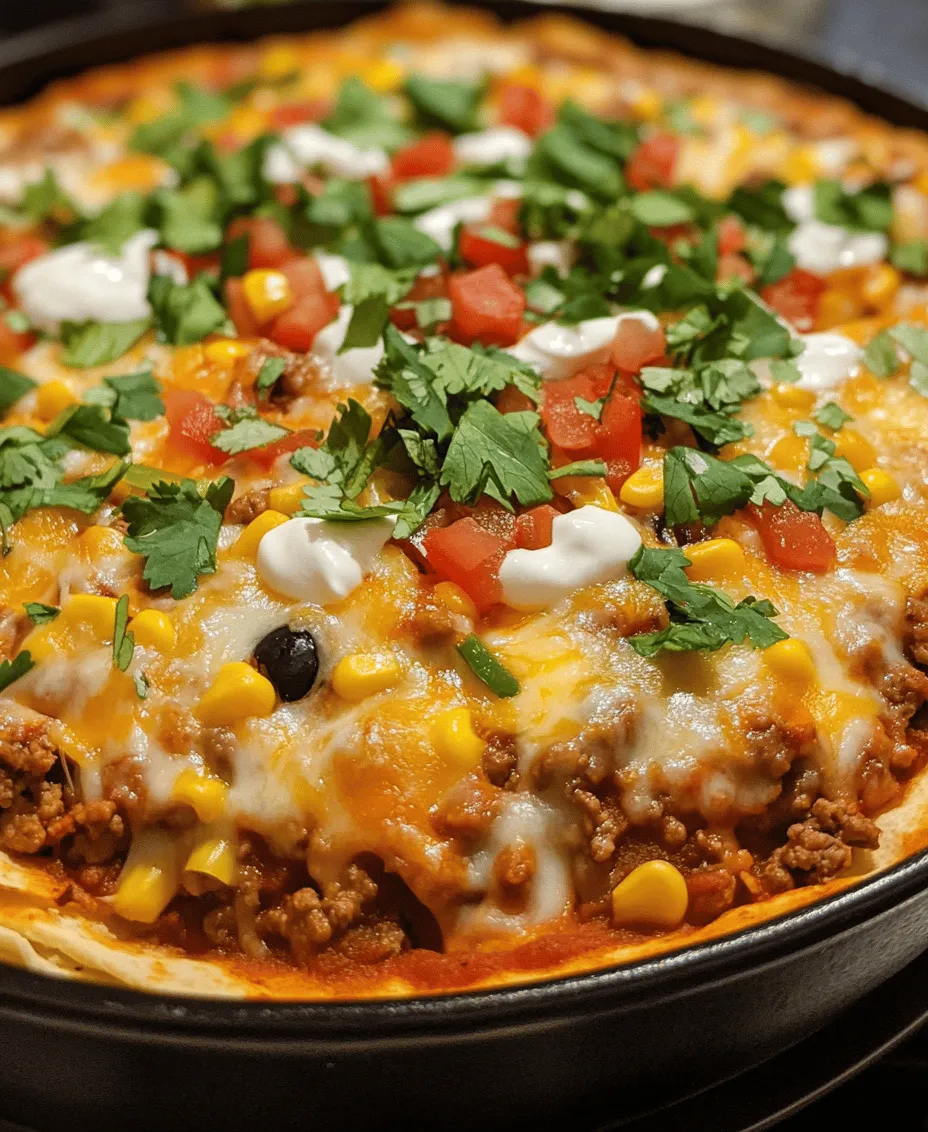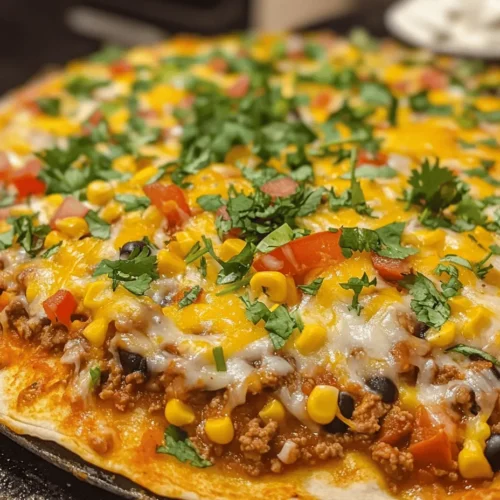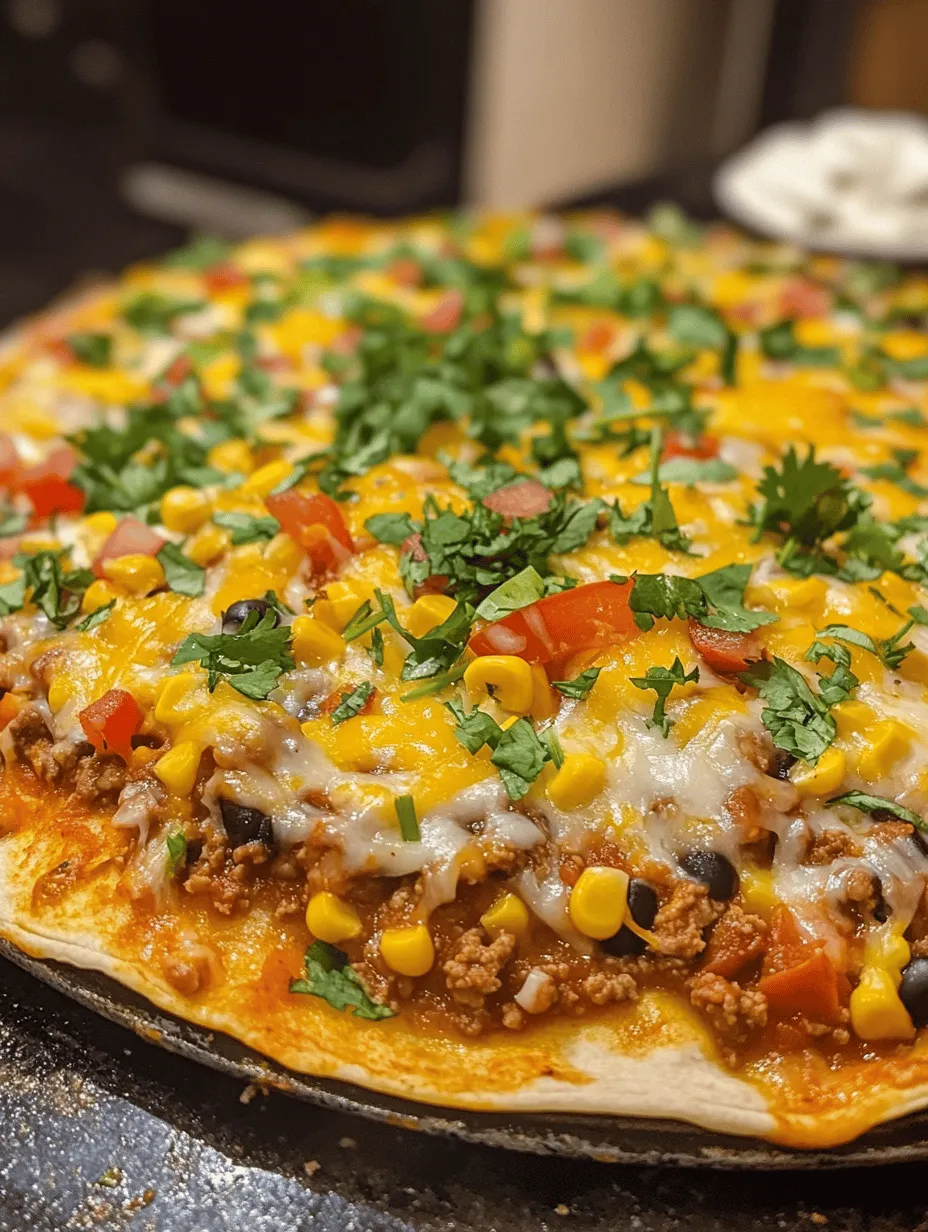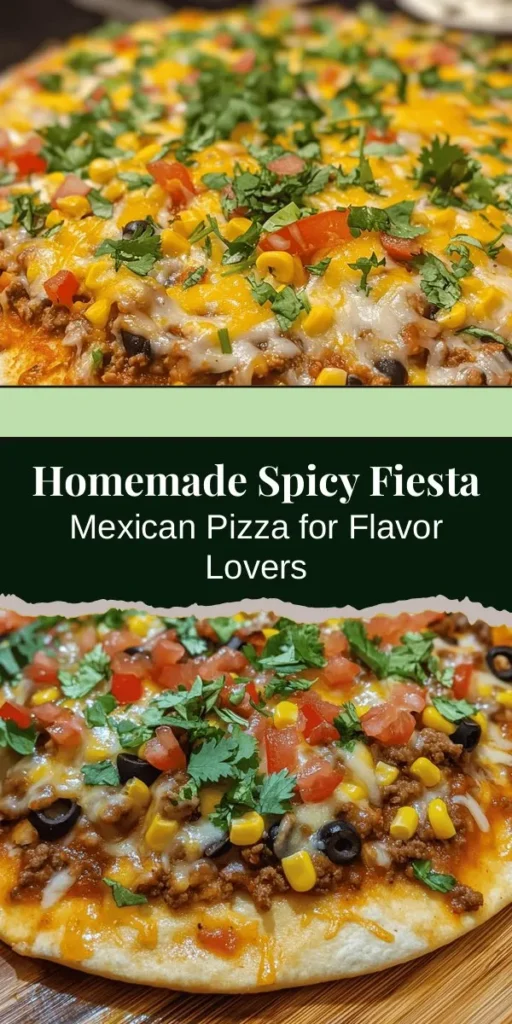Introduction
Mexican cuisine is renowned for its vibrant flavors, colorful presentations, and rich traditions. With ingredients like fresh herbs, zesty spices, and savory proteins, it’s a culinary world full of zest and excitement. Among the many beloved dishes, there is one that stands out as an innovative fusion of flavors and cultures: Mexican pizza. This delectable dish combines the classic elements of a traditional pizza with the bold, spicy tastes of Mexican cooking, creating a unique and satisfying meal that appeals to a wide variety of palates.
In today’s fast-paced world, the demand for easy and quick recipes is greater than ever. Busy lifestyles often leave little room for elaborate meal preparations, making it essential to have go-to recipes that are both simple and delicious. The Spicy Fiesta Homemade Mexican Pizza is an excellent solution for those who want to enjoy a hearty, flavorful meal without spending hours in the kitchen. Whether you’re hosting a gathering with friends or looking for a quick weeknight dinner, this Mexican pizza is sure to impress with its vibrant flavors and satisfying textures.
Understanding the Ingredients
To create the perfect Spicy Fiesta Homemade Mexican Pizza, it is essential to understand the main components that contribute to its deliciousness. Each ingredient plays a critical role in enhancing the overall taste and texture of the dish, making it a delightful experience for everyone at the table.
Flour Tortilla vs. Homemade Pizza Dough: Benefits and Uses
One of the most significant decisions you’ll make when preparing Mexican pizza is whether to use a flour tortilla or opt for homemade pizza dough. Both options have their merits, and the choice ultimately depends on your preferences and time constraints.
Flour tortillas are a fantastic shortcut for those looking to whip up a quick meal. They provide a thin, crispy base that cooks evenly and absorbs the flavors of the toppings. Plus, using tortillas cuts down on preparation time, making it an excellent choice for busy individuals or families.
On the other hand, homemade pizza dough allows for a more traditional pizza experience. If you have the time and enjoy the process of baking, making your own dough can result in a thicker, chewier crust that serves as the perfect canvas for the vibrant toppings of a Mexican pizza. The choice between the two is yours, but both will yield a delicious result.
Refried Beans: Nutritional Value and Preparation Methods
Refried beans are a staple in Mexican cuisine and an essential ingredient in our Spicy Fiesta Homemade Mexican Pizza. Not only do they add a creamy texture that complements the other toppings, but they also provide a good source of protein and fiber. Typically made from pinto or black beans, refried beans can be prepared ahead of time or purchased canned for convenience.
If you’re making your own refried beans, soak dried beans overnight, then simmer them until tender. After cooking, mash the beans with some broth, onion, garlic, and spices to create a flavorful spread that adds depth to your pizza.
Ground Beef and Chorizo: Flavor Profiles and Cooking Tips
For the meat lovers, ground beef and chorizo are the stars of this recipe. Ground beef adds a classic savory flavor that pairs beautifully with the spices and toppings, while chorizo brings a bold, spicy kick that elevates the dish to new heights.
When cooking the meat, it’s important to season it well. A simple combination of salt, pepper, and taco seasoning can enhance the flavors. Ensure that the chorizo is fully cooked and crumbled before adding it to the pizza, as its rich, smoky flavor is a key component of the overall taste.
Vegetables: Importance of Freshness and Variety in Flavors
Fresh vegetables not only add vibrant colors to your Mexican pizza but also contribute essential nutrients and textures. Consider using diced bell peppers, red onions, jalapeños, and corn to create a medley of flavors that complement the meat and beans.
Using a variety of vegetables not only enhances the visual appeal of the dish but also balances the richness of the cheese and meat, making every bite a delightful experience. When preparing your vegetables, opt for the freshest produce available, as this will significantly affect the overall flavor of your pizza.
Cheese Selection: The Role of Mexican Blend Cheese in the Recipe
Cheese is a crucial component of any pizza, and for our Spicy Fiesta Homemade Mexican Pizza, a Mexican blend cheese is the perfect choice. Typically made from a combination of cheddar, Monterey Jack, and queso blanco, this cheese blend melts beautifully and adds a creamy texture to the dish.
Feel free to experiment with different cheese varieties, such as pepper jack for an extra kick or crumbled queso fresco for a more authentic touch. The right cheese will not only enhance the flavor but also create that gooey, melty experience that everyone loves in a pizza.
Additional Ingredients: Taco Seasoning, Salsa, and Garnishes
To bring out the full spectrum of flavors in your Mexican pizza, don’t forget to incorporate taco seasoning and salsa. Taco seasoning adds a punch of flavor and spices, making your pizza even more exciting. You can either use a store-bought seasoning or create your own blend using chili powder, cumin, garlic powder, and oregano.
Salsa, whether homemade or store-bought, can be used as both a topping and a dipping sauce. The freshness of the salsa adds a delightful contrast to the richness of the cheese and meat, enhancing the overall flavor profile.
Finally, garnishes such as fresh cilantro, avocado slices, or a dollop of sour cream can elevate your Mexican pizza to a whole new level. These finishing touches not only add flavor but also make your dish visually appealing.
Preparation Steps Explained
Now that we have a clear understanding of the ingredients that make up our Spicy Fiesta Homemade Mexican Pizza, let’s dive into the initial preparation steps that will set you on the right path to creating this delectable dish.
Preheating the Oven: Importance of Temperature in Baking
Before you begin assembling your pizza, it’s crucial to preheat your oven. The ideal temperature for baking pizzas is around 425°F (220°C). Preheating ensures that your pizza cooks evenly and achieves that perfect crispy crust. If you’re using pizza dough, a hot oven will help it rise properly, creating a light and airy texture.
Preparing the Base: Differences Between Using a Tortilla and Pizza Dough
Depending on your choice of base, you’ll want to prepare accordingly. If you’re using flour tortillas, simply lay them on a baking sheet lined with parchment paper. If you’ve opted for homemade pizza dough, roll it out to your desired thickness and shape, then place it on a pizza stone or baking sheet.
If using tortillas, you may want to lightly crisp them in the oven for a few minutes before adding toppings. This will help prevent them from becoming soggy during baking. For homemade dough, ensure it is rolled out evenly to promote even cooking.
Tips for Achieving the Perfect Base Texture
Regardless of the base you choose, several tips can help you achieve the ideal texture for your pizza. If using pizza dough, make sure to stretch it gently rather than rolling it too thin, as this can lead to a tough crust. Allow the dough to rest for a few minutes before shaping it, allowing the gluten to relax for easier handling.
For both types of crusts, consider brushing a bit of olive oil on the surface before adding toppings. This creates a barrier that helps to lock in moisture and adds a delicious flavor.
Layering the Ingredients: The Art of Building Flavors
The final step before baking is layering your ingredients. Start with a generous spread of refried beans across the base, followed by a layer of seasoned ground beef and chorizo. Next, add your fresh vegetables, distributing them evenly for balanced flavor in every bite.
Top it all off with a generous handful of Mexican blend cheese, ensuring that every inch of the pizza is covered. Don’t forget to sprinkle some taco seasoning over the top for that extra burst of flavor.
With all the ingredients layered beautifully, your Spicy Fiesta Homemade Mexican Pizza is ready to be baked to perfection.
—
In this first part of our detailed guide on making Spicy Fiesta Homemade Mexican Pizza, we explored the vibrant world of Mexican cuisine, the essential ingredients that make this dish a standout, and the initial preparation steps necessary to create a delicious pizza at home. Stay tuned for the next part of the article, where we will cover the baking process and provide expert tips to achieve the best results!

Importance of Even Distribution of Each Layer
When creating your Spicy Fiesta Homemade Mexican Pizza, the importance of evenly distributing each layer cannot be overstated. Each component plays a crucial role in the overall flavor and texture of the pizza. Start with the base, ensuring a uniform spread of the refried beans. This not only adds a rich and creamy texture but also acts as a barrier, preventing the crust from becoming soggy. Next, sprinkle your taco seasoning evenly across the beans, followed by the cheese which should be distributed generously yet evenly to ensure every bite is cheesy and flavorful.
As you layer the toppings—like cooked ground beef or a vegetarian substitute—spread them out evenly across the pizza. This ensures that no single slice is overloaded while others are lacking. Lastly, when it comes to adding fresh toppings like diced tomatoes, jalapeños, and onions, aim for a colorful and balanced distribution. This not only enhances the visual appeal but also provides a burst of flavor in every mouthful.
Baking the Pizza: What to Look for to Know When It’s Done
Baking your Spicy Fiesta Homemade Mexican Pizza is an essential step that can greatly influence the final outcome. Preheat your oven to 425°F (220°C) to ensure that the pizza cooks evenly. Bake the pizza for about 20 to 25 minutes. As it bakes, keep an eye on the cheese—it should melt beautifully and start to bubble. The moment you see the cheese turning a light golden brown, you’re close to perfection.
Another indicator of doneness is the crust. When it reaches a golden brown color and feels firm to the touch, it’s usually ready to come out of the oven. If you tap the crust gently, it should sound hollow, which is a good sign that it’s thoroughly cooked.
Visual Cues and Texture Indicators
When baking, pay attention to visual cues and texture indicators. The cheese should not only be melted but also slightly browned, giving it that delicious, inviting appearance typical of a well-cooked pizza. The edges of the crust should be crisp, while the center should remain slightly soft but not doughy. If you notice that the toppings, especially the jalapeños or any other vegetables, have developed a slight char, this adds an extra layer of flavor, enhancing the overall experience.
Flavor Profile and Customization
Discussion on the Balance of Flavors: Spicy, Savory, and Creamy
The Spicy Fiesta Homemade Mexican Pizza is a delightful blend of spicy, savory, and creamy flavors that create a harmonious balance. The spicy notes come primarily from the taco seasoning and fresh jalapeños, providing a fiery kick that’s perfectly complemented by the savory depth of the refried beans and the richness of melted cheese. The creamy texture of sour cream or guacamole drizzled on top offers a cooling effect, balancing the heat and tying all the flavors together.
Customizing the Pizza
Vegetarian Options: Substitutes for Meat
One of the great advantages of this Mexican pizza recipe is its versatility. For those looking to enjoy a vegetarian version, there are several substitutes for meat that can still provide a hearty and satisfying meal. Consider using black beans, lentils, or textured vegetable protein (TVP) seasoned with taco spices as a protein-rich base. Additionally, grilled vegetables like zucchini, bell peppers, and mushrooms can add depth and flavor, making the pizza just as delicious without the meat.
Heat Levels: Adjusting Jalapeño and Other Spicy Ingredients
If you’re sensitive to spice or simply prefer a milder flavor, it’s easy to adjust the heat level in your pizza. Start by reducing the amount of jalapeños or opting for milder varieties, such as banana peppers or roasted red peppers. Alternatively, you can deseed the jalapeños before adding them to the pizza, which will significantly decrease their heat. For those who enjoy a bit of an extra kick, consider adding sliced serrano peppers or a drizzle of hot sauce just before serving to elevate the flavor without overpowering the dish.
Additional Toppings: Suggestions for Personalizing Your Pizza
Customization doesn’t stop at the base ingredients. Feel free to get creative with additional toppings that reflect your personal taste. Some popular choices include sliced olives, corn, or even pineapple for a sweet twist. Fresh cilantro sprinkled on top after baking adds a refreshing touch. For a gourmet experience, consider drizzling balsamic reduction or a yogurt-based sauce over the finished pizza for an unexpected flavor burst.
Serving Suggestions
Best Practices for Serving the Spicy Fiesta Pizza
When it comes to serving your Spicy Fiesta Pizza, presentation is key. Allow the pizza to cool for a few minutes after baking, making it easier to slice without the toppings sliding off. Use a sharp pizza cutter to ensure clean cuts, and serve hot for the best experience. You can also serve it on a wooden cutting board or a colorful platter to enhance the visual presentation.
Pairing Ideas: What Drinks or Sides Complement the Dish
Pairing your pizza with the right drinks can elevate the dining experience. Consider serving it with chilled beverages like a light lager, a refreshing margarita, or even a fruity sangria, which all complement the spicy flavors of the pizza beautifully. For sides, think about serving a fresh salad topped with a zesty lime vinaigrette or homemade tortilla chips with guacamole and salsa for a complete meal that’s sure to impress.
Presentation Tips to Make the Pizza Visually Appealing
To make your pizza visually appealing, consider the colors and textures of your toppings. Use a variety of colorful vegetables, and arrange them thoughtfully over the cheese. A sprinkle of fresh herbs like cilantro or parsley can add a pop of green and enhance the overall look. Serve slices on plates garnished with a dollop of sour cream, avocado slices, or a sprinkle of extra cheese for an inviting touch.
Nutritional Information
Breakdown of Key Nutritional Elements Per Serving
Understanding the nutritional content of your Spicy Fiesta Homemade Mexican Pizza can help you enjoy it guilt-free. A typical serving (1/8 of the pizza) provides approximately 300-400 calories, depending on the toppings used. Key nutritional elements include around 20 grams of protein (if using meat), 15 grams of fat (with cheese and sour cream), and 30 grams of carbohydrates from the crust and beans.
Benefits of Using Fresh Ingredients and Balanced Nutrition
Utilizing fresh ingredients not only enhances the flavor profile but also boosts the nutritional value. Fresh vegetables add vitamins, minerals, and antioxidants, while whole grain crust options can increase fiber content. Choosing lean meats or vegetarian alternatives can further reduce fat intake, making this pizza a more balanced choice compared to traditional options loaded with processed ingredients.
Comparison to Traditional Pizza and Its Nutritional Advantages
When compared to traditional pizza, which often relies heavily on processed meats and refined flour crusts, the Spicy Fiesta Pizza offers several nutritional advantages. By incorporating beans for protein and fiber, along with a variety of fresh toppings, this pizza becomes a more wholesome meal. Additionally, you can control the amount of cheese and toppings, allowing for a healthier version without sacrificing flavor.
Conclusion
The Spicy Fiesta Homemade Mexican Pizza is not merely a meal; it’s a celebration of flavors that brings friends and family together. Whether enjoyed on a casual weeknight or served at a festive gathering, this pizza is versatile enough to satisfy a wide range of palates. The ability to experiment with flavors and ingredients allows each cook to create a unique twist, making it a dish that can be reinvented time and time again.
Don’t shy away from trying new combinations or adjusting the heat levels to suit your preferences. The joy of cooking lies in the exploration of flavors and the delight of sharing these culinary creations with your loved ones. So gather your ingredients, roll up your sleeves, and embark on the delicious journey of making your very own Spicy Fiesta Homemade Mexican Pizza. Happy cooking!



